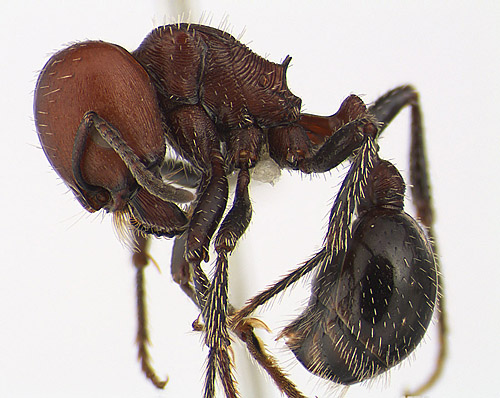I don't ordinarily do product endorsements on the blog, but here's one: the image-stacking software CombineZP. I recommend it for two reasons. First, CombineZP produces smoother, more artifact-free images than the very expensive competition. Second, CombineZP is freeware. Alan Hadley, a British arthropod enthusiast, wrote it in his spare time.
Good. And free. Not much to argue with there.
CombineZP and similar products are designed to counter a major challenge of macrophotography, the narrow depth of field at high magnification.Â
With standard optics, getting an entire insect at close range into focus is difficult to impossible.  These programs solve the problem by taking multiple photos from different focal depths and merging the sharp parts of each into a single fully-focused image.
The technology is especially useful for preserved insect specimens. Antweb, for example, has employed several of these sorts of programs to assemble a library of more than 30,000 focus-stacked ant images.
If you'd like to get into the specimen imaging game and already have a scope with a camera attached, CombineZP means you don't need to drop any additional money on stacking software. That's the situation our wasp lab was in: we had a partial image system assembled from various bits and parts but lacked the final- and presumably expensive- stacking software. It made my week to discover a free program that stacked images quickly and cleanly.
Caveats apply, of course. CombineZP lacks the full set of bells and whistles included in commercial competitors. The user interface is very much a get-what-you-pay-for clunker that will transport you back to your favorite Windows programs from 1992. And it is Windows-only. But the heart of CombineZP, the underlying algorithms that align and stack the images, are about as good as they come.


I have tried CombineZP on a friends computer, and was very impressed for a freeware piece of software.
Unfortunately though, I am a mac user so had to seek an alternative. I've been using http://www.heliconsoft.com/heliconfocus.html recently, and it's great for the price. If anyone uses a mac and needs a focus stacker... i recommend checking it out.
(If you wish to remove the link Alex - no problem!)
I've not tried Helicon yet, but I hear nothing but good things about it. At least, the word on the street is that it's worth the modest price tag.
I've been playing with CombineZP as well, after seeing the work of Charles Krebs and Brian Valentine. They produce some amazing pictures with the photo-stacking technique.
It might just a personal preference of mine, but I'm not a huge fan of stacked images of live insects. While the images can look sharp and striking, they don't necessarily look...natural.
FYI, there's also a free plugin for free ImageJ (multiplatform):
http://bigwww.epfl.ch/demo/edf/
(note: requires that your stack of images are perfectly aligned, which can be done with another plugin)
It's the program I first experimented with for stacking photos. It produces excellent results, so my hat's off to Alan Hadley. My only comment is that I dislike the user interface. This is not a criticism, it is freeware afterall.
But this did lead me to trying out Helicon Focus. It's not too expensive and can a trial version can be downloaded. I found it produced similar results but is easier to work with. So that was enough for me to purchase.
Also don't forget Photoshop CS4 offers stacking capabilities too. So, if you've invested in this powerful program already, play with this feature. It is very good.
I forgot to ask, did you take the above photo with your EOS or with a stereoscope CCD camera? The quality is far superior to what I am getting with a stereo microscope CCD setup...
Hmmm... could this be applied to widefield microscopy somehow? Usually we just keep our stacks separate (more practical that way), but what would happen if you combine them on top of each other?
Yannick, thanks for the IJ plugin!
Brb, some playing to do...
I've been using the various version of Combine for a couple of years and I agree that it is a fine program for stacking reflected light images. The interface is a bit clunky, but CombineZP is the best so far.
I've even used it to stack SEMS after Laurie Knight* suggested trying. You have to crop out any information bars or you get a weird inversion of part of the stack, but if you crop the SEMs to the grayscale region and the exact same size, then it often works fine and can be much faster than my usual John Henry approach of manually layering in Photoshop.
The main problem I have with image stacking software, however, is in using transmitted light (cleared mites on microscope slides). I can rarely combine more than 2-3 layers before the pixilation and blurring become extreme. An additional, and probably unsolvable, problem is that the upper and lower (and anything in between) surfaces easily become merged â the picture may look okay, but no animal with those characters exists.
Iâve used some very fancy integrated compound microscope systems (e.g. Olympus, Leica) and have taken and stacked as many as 300 layers of a micron or so in a few seconds. Thatâs pretty impressive, but the results with transmitted light microscopy havenât been great and mostly Iâve had to default to the 2-3 layer option. If anyone has any suggestions on how to improve depth of field with transmitted light, then Iâd be interested to hear about it.
* Laurie Knight has done some fantastic megastacks of dead insects - so Alex may approve - http://www.laurieknight.net/gallery/bugs/1
Pete- I took those with a 3MP CCD video camera through a Leica stereoscope.